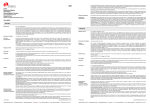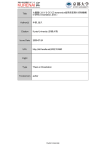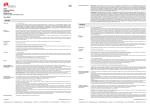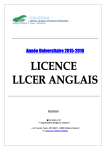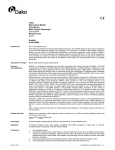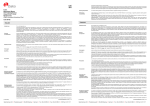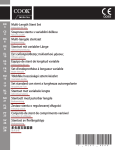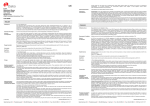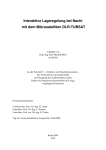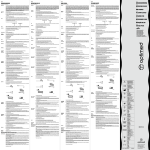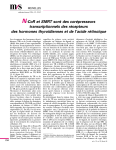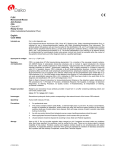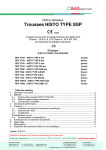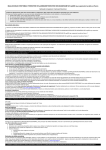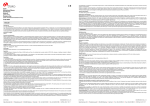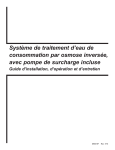Download FLEX Monoclonal Mouse Anti-Human MutL Protein Homolog
Transcript
FLEX Monoclonal Mouse Anti-Human MutL Protein Homolog 1 Clone ES05 Ready-to-Use (Dako Autostainer/Autostainer Plus) Code IS079 English Intended use For in vitro diagnostic use. FLEX Monoclonal Mouse Anti-Human MutL Protein Homolog 1, Clone ES05 Ready-to-Use, (Dako Autostainer/Autostainer Plus), is intended for use in immunohistochemistry together with Dako Autostainer/Autostainer Plus instruments. This antibody is useful for the differential identification of colorectal carcinoma. When deficient, the MutL Protein Homolog 1 (MLH1) is associated with the onset of hereditary nonpolyposis colorectal cancer (HNPCC). The clinical interpretation of any staining or its absence should be complemented by morphological studies using proper controls and should be evaluated within the context of the patient's clinical history and other diagnostic tests by a qualified pathologist. Summary and explanation Mismatch repair gene hMLH1 is a ubiquitous gene encoding a mismatch repair protein (MMR) called MutL protein homolog 1 (MLH1) which is utilized by normal proliferating cells to repair point mutations that may occur during DNA replication. MLH1 forms a heterodimer with the mismatch repair protein MutL protein homolog 2 (PMS2) and the MLH1-PMS2 heterodimeric complex is recruited to the mismatch DNA sequence by a MutS MMR heterodimeric complex consisting of the MSH2-MSH6 heterodimer, which binds directly to the base mismatch repair error. The MLH1-PMS2 complex then initiates downstream repair functions including the excision of the mismatched DNA strand and repair through the recruitment of nucleases, polymerases, and other assorted proteins. The mismatched nucleotides, or microsatellite instable (MSI) sequence, targeted by the heterodimer are consequently repaired as the result of normal dimerization of the two proteins in an ATPdependent process (1-3). MLH1 deficiency is often the result of germline mutations in MMR deficient individuals (4). Absence of MLH1 has also been reported in 10-15% of sporadic colorectal carcinomas (5). Individuals lacking the MLH1 protein are predisposed for hereditary non-polyposis colorectal cancer (HNPCC). HNPCC is an autosomal dominant disorder associated with a high risk for developing colorectal cancer (1-4,6). Additionally, HNPCC increases the risk for extracolonic cancers including carcinoma of the endometrium, ovary, renal pelvis, small bowel, stomach and ureter (6). HNPCC is believed to account for approximately 2 - 5% of all colorectal cancers with about 50% of HNPCC mutations occurring in the MutL homologue 1 gene (4,7). Antibodies to MLH1 are useful for identifying mismatch repair deficiencies in tumors of the gastrointestinal tract including HNPCC and associated extracolonic cancers by immunohistochemistry (IHC). MLH1 deficiency as determined by IHC has been reported in 80.3% of MSI-High colon carcinomas and 12.4% of endometrial carcinomas associated with HNPCC (8,9). Loss of MLH1 expression has also been reported in gastric adenoma, intramucosal carcinoma, noninvasive squamous cell carcinoma of the uterine cervix, pancreatic carcinoma and sebaceous gland tumors (10-13). Refer to Dako’s General Instructions for Immunohistochemical Staining or the detection system instructions of IHC procedures for: 1) Principle of Procedure, 2) Materials Required, Not Supplied, 3) Storage, 4) Specimen Preparation, 5) Staining Procedure, 6) Quality Control, 7) Troubleshooting, 8) Interpretation of Staining, 9) General Limitations. Reagent provided Ready-to-use monoclonal mouse antibody provided in liquid form as cell culture supernatant (containing fetal bovine serum) dialyzed against 0.05 mol/L Tris/HCl, pH 7.2, and containing 0.015 mol/L NaN3. Clone: ES05. Isotype: IgG1, kappa. Immunogen Recombinant protein corresponding to a 210 amino acid portion of the human MLH1 molecule. Specificity In Western blotting of human Caco-2 cell lysate, the antibody labels a major band at 88 kDa corresponding to the expected molecular weight of MLH1 (14). (119332-001) 307806EFG_001 1/7 Precautions 1. For professional users. 2. This product contains sodium azide (NaN3), a chemical highly toxic in pure form. At product concentrations, though not classified as hazardous, sodium azide may react with lead and copper plumbing to form highly explosive build-ups of metal azides. Upon disposal, flush with large volumes of water to prevent metal azide build-up in plumbing. 3. As with any product derived from biological sources, proper handling procedures should be used. 4. Wear appropriate Personal Protective Equipment to avoid contact with eyes and skin. 5. Unused solution should be disposed of according to local, State and Federal regulations. Storage Store at 2–8 °C. Do not use after expiration date s tamped on vial. If reagents are stored under any conditions other than those specified, the conditions must be verified by the user. There are no obvious signs to indicate instability of this product. Therefore, positive and negative controls should be run simultaneously with patient specimens. If unexpected staining is observed which cannot be explained by variations in laboratory procedures and a problem with the antibody is suspected, contact Dako Technical Support. Specimen preparation including materials required but not supplied The antibody can be used for labeling formalin-fixed, paraffin-embedded tissue sections. Tissue specimens should be cut into sections of approximately 4 µm. Pre-treatment with heat-induced epitope retrieval (HIER) is required using Dako PT Link (Code PT100/PT101). For details, please refer to the PT Link User Guide. Optimal results are obtained by pretreating tissues using EnVision FLEX Target Retrieval Solution, High pH (50x) (Code K8010/K8014). Paraffin-embedded sections: Pre-treatment of formalin fixed, paraffin-embedded tissue sections is recommended using the 3-in-1 specimen preparation procedure for Dako PT Link. Follow the pre-treatment procedure outlined in the package insert for EnVision FLEX Target Retrieval Solution, High pH (50x) (Code K8010/K8014). Note: After staining the sections must be dehydrated, cleared and mounted using permanent mounting medium. Deparaffinized sections: Pre-treatment of deparaffinized formalin-fixed, paraffin-embedded tissue sections is recommended using Dako PT Link and following the same procedure as described for paraffin-embedded sections. After staining the slides should be mounted using aqueous or permanent mounting medium. The tissue sections should not dry out during the treatment or during the following immunohistochemical staining procedure. For greater adherence of tissue sections to glass slides, the use of FLEX IHC Microscope Slides (Code K8020) is recommended. Staining procedure including materials required but not supplied The recommended visualization system is EnVision FLEX+, Mouse, High pH, (Dako Autostainer/Autostainer Plus) (Code K8012). The staining steps and incubation times are pre-programmed into the software of Dako Autostainer/Autostainer Plus instruments, using the following protocols: Template protocol: FLEXRTU2 (200 µL dispense volume) or FLEXRTU3 (300 µL dispense volume) Autoprogram: mlh (without counterstaining) or mlhH (with counterstaining) The Auxiliary step should be set to “rinse buffer” in staining runs with ≤10 slides. For staining runs with >10 slides the Auxiliary step should be set to “none”. This ascertains comparable wash times. All incubation steps should be performed at room temperature. For details, please refer to the Operator’s Manual for the dedicated instrument. If the protocols are not available on the used Dako Autostainer instrument, please contact Dako Technical Services. Optimal conditions may vary depending on specimen and preparation methods, and should be determined by each individual laboratory. If the evaluating pathologist should desire a different staining intensity, a Dako Application Specialist/Technical Service Specialist can be contacted for information on re-programming of the protocol. Verify that the performance of the adjusted protocol is still valid by evaluating that the staining pattern is identical to the staining pattern described in “Performance characteristics”. Counterstaining in hematoxylin is recommended using EnVision FLEX Hematoxylin, (Dako Autostainer/Autostainer Plus) (Code K8018). Non-aqueous, permanent mounting medium is recommended. Positive and negative controls should be run simultaneously using the same protocol as the patient specimens. The positive control tissue should include appendix, colon, and tonsil and the cells/structures should display reaction patterns as described for these tissues in “Performance characteristics” in all positive specimens. The recommended negative control reagent is FLEX Negative Control, Mouse, (Dako Autostainer/Autostainer Plus) (Code IS750). Staining interpretation The cellular staining pattern is nuclear. Performance characteristics Normal tissues: FLEX Monoclonal Mouse Anti-Human MutL Protein Homolog 1, Clone ES05 positively identifies the nuclei of a variety of cell types in normal tissue. The nuclei of epithelial cells are labeled by the antibody in appendix, breast, cervix, colon, esophagus, kidney, lung, pancreas, prostate, salivary gland, small intestine, thyroid, tonsil and uterus. Positive immunoreactivity is observed in stromal cells and endothelial cells present in many tissue types. The antibody also labels the nuclei of lymphocytes of the tonsil and gastrointestinal tract and endocrine cells of pituitary and parathyroid. Other tissue elements which demonstrate positivity include adipocytes, bone marrow blasts, mesothelium, nerve plexi, smooth muscle of appendix and uterine myometrium (15). (119332-001) 307806EFG_001 2/7 Français Utilisation prévue Réf. IS079 Pour utilisation diagnostique in vitro. L’anticorps FLEX Monoclonal Mouse Anti-Human MutL Protein Homolog 1, Clone ES05 Ready-to-Use, (Dako Autostainer/Autostainer Plus), est destiné à être utilisé en immunohistochimie avec les appareils Dako Autostainer/Autostainer Plus. Cet anticorps est utile pour l’identification différentielle des carcinomes colorectaux. Lorsqu’il est déficient, l’homologue 1 de la protéine MutL (MLH1) est associé à l’apparition d'un cancer colorectal héréditaire sans polypose ou syndrome HNPCC (hereditary non-polyposis colorectal cancer). L’interprétation clinique de toute coloration ou son absence doit être complétée par des études morphologiques en utilisant des contrôles appropriés et doit être évaluée en fonction des antécédents cliniques du patient et d’autres tests diagnostiques par un pathologiste qualifié. Résumé et explication Le gène de réparation des mésappariements hMLH1 est un gène ubiquitaire codant une protéine de réparation des mésappariements (MMR) appelée homologue 1 de la protéine MutL (MLH1) qui est utilisée par les cellules en prolifération saines afin de réparer les mutations ponctuelles qui peuvent survenir au cours de la réplication de l’ADN. MLH1 forme un hétérodimère avec la protéine de réparation des mésappariements homologue 2 de la protéine MutL (PMS2) et le complexe hétérodimérique MLH1-PMS2 est recruté pour la séquence ADN mésappariée par un complexe hétérodimérique de réparation des mésappariements MutS composé de l’hétérodimère MSH2-MSH6, qui se lie directement là où se trouve l’erreur de réparation du mésappariement de la base. Le complexe MLH1-PMS2 initie ensuite des fonctions de réparation en aval, y compris l’excision du brin d’ADN mésapparié et la réparation grâce au recrutement de nucléases, de polymérases et d’autres protéines associées. Les nucléotides mésappariés, ou séquence d’instabilité des microsatellites (MSI), ciblés par l’hétérodimère sont alors réparés suite à la dimérisation normale des deux protéines lors d’un processus ATPdépendant (1-3). Une déficience en MLH1 est souvent le résultat de mutations au niveau des lignées germinales chez des individus présentant une déficience du système de réparation des mésappariements (4). L’absence de MLH1 a également été rapportée dans 10 à 15 % des cancers colorectaux sporadiques (5). Les individus dépourvus de la protéine MLH1 présentent une prédisposition au cancer colorectal héréditaire sans polypose (ou syndrome HNPCC). Le syndrome HNPCC est un trouble dominant autosomique associé à un fort risque de développement d’un cancer colorectal (1-4,6). De plus, le syndrome HNPCC augmente le risque de cancers extra-coliques, notamment le carcinome de l’endomètre, de l’ovaire, du bassinet du rein, du petit intestin, de l’estomac et de l’uretère (6). On pense que ce syndrome représente environ 2 à 5 % de l’ensemble des cancers colorectaux avec environ 50 % des mutations de type HNPCC survenant dans le gène de l’homologue 1 de MutL (4,7). Les anticorps dirigés contre MLH1 sont utiles pour identifier, par immunohistochimie (IHC), les déficiences de la réparation des mésappariements dans les tumeurs de l’appareil gastro-intestinal, y compris le syndrome HNPCC et les cancers extra-coliques associés. Une déficience en MLH1, déterminée par IHC, a été rapportée dans 80,3 % des carcinomes du côlon à forte instabilité des microsatellites et dans 12,4 % des carcinomes endométriaux associés au syndrome HNPCC (8,9). Une perte de l’expression de MLH1 a également été signalée dans l’adénome gastrique, le carcinome intramuqueux, le carcinome épidermoïde non invasif du col de l’utérus, le carcinome pancréatique et les tumeurs des glandes sébacées (10-13). Se reporter aux « Instructions générales de coloration immunohistochimique » de Dako ou aux instructions du système de détection relatives aux procédures IHC pour plus d’informations concernant les points suivants : 1) Principe de procédure, 2) Matériels requis mais non fournis, 3) Conservation, 4) Préparation des échantillons, 5) Procédure de coloration, 6) Contrôle qualité, 7) Dépannage, 8) Interprétation de la coloration, 9) Limites générales. Réactifs fournis Anticorps monoclonal de souris prêt à l’emploi fourni sous forme liquide comme surnageant de culture cellulaire (contenant du sérum bovin fœtal) dialysé en utilisant 0,05 mol/L de tampon Tris-HCl, de pH 7,2 et contenant 0,015 mol/L de NaN3. Clone : ES05. Isotype : IgG1, kappa. Immunogène Protéine recombinante correspondant à une portion de 210 acides aminés de la molécule MLH1 humaine. Spécificité Lors de Western Blots de lysats de cellules Caco-2 humaines, l’anticorps marque une bande principale à 88 kDa correspondant au poids moléculaire attendu de MLH1 (14). Précautions 1. Pour utilisateurs professionnels. 2. Ce produit contient de l’azide de sodium (NaN3), un produit chimique hautement toxique sous sa forme pure. Aux concentrations du produit, bien que non classé comme dangereux, l’azide de sodium peut réagir avec le cuivre et le plomb des canalisations et former des accumulations d’azides métalliques hautement explosives. Lors de l’élimination, rincer abondamment à l’eau pour éviter toute accumulation d’azide métallique dans les canalisations. 3. Comme avec tout produit d’origine biologique, des procédures de manipulation appropriées doivent être respectées. (119332-001) 4. Porter un vêtement de protection approprié pour éviter le contact avec les yeux et la peau. 5. Les solutions non utilisées doivent être éliminées conformément aux réglementations locales et nationales. 307806EFG_001 3/7 Conservation Conserver entre 2 et 8 °C. Ne pas utiliser après la date de péremption imprimée sur le flacon. Si les réactifs sont conservés dans des conditions autres que celles indiquées, celles-ci doivent être validées par l’utilisateur. Il n’y a aucun signe évident indiquant l’instabilité de ce produit. Par conséquent, des contrôles positifs et négatifs doivent être testés en même temps que les échantillons de patients. Si une coloration inattendue est observée, qui ne peut être expliquée par des différences dans les procédures du laboratoire et qu’un problème lié à l’anticorps est suspecté, contacter l’assistance technique de Dako. Préparation des échantillons y compris le matériel requis mais non fourni L’anticorps peut être utilisé pour le marquage des coupes de tissus fixées au formol et incluses en paraffine. L'épaisseur des coupes d'échantillons de tissu doit être d’environ 4 µm. Le prétraitement avec un démasquage d’épitope induit par la chaleur (HIER) est nécessaire à l’aide de l’appareil PT Link de Dako (réf. PT100/PT101). Pour plus de détails, se reporter au Guide d’utilisation du PT Link. Pour obtenir des résultats optimaux, prétraiter les tissus à l’aide du produit EnVision FLEX Target Retrieval Solution, High pH (50x) (réf. K8010/K8014). Coupes incluses en paraffine : Il est recommandé de prétraiter les coupes de tissus fixées au formol et incluses en paraffine à l’aide de la procédure de préparation des échantillons 3 en 1 du PT Link de Dako. Suivre la procédure de prétraitement indiquée dans la notice du produit EnVision FLEX Target Retrieval Solution, High pH (50x) (réf. K8010/K8014). Remarque : Après coloration, les coupes doivent être déshydratées, éclaircies et montées à l’aide d’un milieu de montage permanent. Coupes déparaffinées : Il est recommandé de prétraiter les coupes de tissus fixées au formol et incluses en paraffine qui ont été déparaffinées à l’aide du PT Link de Dako et de suivre la même procédure que celle décrite pour les coupes incluses en paraffine. Après coloration, un montage aqueux ou permanent des lames est recommandé. Les coupes de tissus ne doivent pas sécher lors du traitement ni lors de la procédure de coloration immunohistochimique suivante. Pour une meilleure adhérence des coupes de tissus sur les lames de verre, il est recommandé d’utiliser des lames FLEX IHC Microscope Slides (réf. K8020). Procédure de coloration y compris le matériel requis mais non fourni Le système de visualisation recommandé est le système EnVision FLEX+, Mouse, High pH, (Dako Autostainer/Autostainer Plus) (réf. K8012). Les étapes de coloration et les temps d’incubation sont préprogrammés dans le logiciel des appareils Dako Autostainer/Autostainer Plus, à l’aide des protocoles suivants : Protocole modèle : FLEXRTU2 (volume d’application de 200 µL) ou FLEXRTU3 (volume d’application de 300 µL) Programme automatique : mlh (sans contre-coloration) ou mlhH (avec contre-coloration) L’étape Auxiliary doit être réglée sur « rinse buffer » lors des cycles de coloration avec ≤10 lames. Pour les cycles de coloration de >10 lames, l’étape Auxiliary doit être réglée sur « none ». Cela garantit des temps de lavage comparables. Toutes les étapes d’incubation doivent être effectuées à température ambiante. Pour plus de détails, se reporter au Manuel de l’opérateur spécifique à l'appareil. Si les protocoles ne sont pas disponibles sur l’appareil Dako Autostainer utilisé, contacter le service technique de Dako. Les conditions optimales peuvent varier en fonction du prélèvement et des méthodes de préparation, et doivent être déterminées par chaque laboratoire individuellement. Si le pathologiste qui réalise l’évaluation désire une intensité de coloration différente, un spécialiste d’application/spécialiste du service technique de Dako peut être contacté pour obtenir des informations sur la reprogrammation du protocole. Vérifier que l'exécution du protocole modifié est toujours valide en vérifiant que le schéma de coloration est identique au schéma de coloration décrit dans les « Caractéristiques de performance ». Il est recommandé d’effectuer une contre-coloration à l’hématoxyline en utilisant le produit EnVision FLEX Hematoxylin, (Dako Autostainer/Autostainer Plus) (réf. K8018). L’utilisation d’un milieu de montage permanent non aqueux est recommandée. Des contrôles positifs et négatifs doivent être réalisés en même temps et avec le même protocole que les échantillons du patient. Le tissu de contrôle positif doit comprendre l’appendice, le côlon et l’amygdale et les cellules/structures doivent présenter des schémas de réaction tels que décrits pour ces tissus dans les « Caractéristiques de performance » pour tous les échantillons positifs. Le réactif de contrôle négatif recommandé est le produit FLEX Negative Control, Mouse, (Dako Autostainer/Autostainer Plus) (réf. IS750). Interprétation de la coloration Le schéma de coloration cellulaire est nucléaire. Caractéristiques de performance Tissus sains : L’anticorps FLEX Monoclonal Mouse Anti-Human MutL Protein Homolog 1, Clone ES05, identifie de façon positive les noyaux de divers types cellulaires dans les tissus sains. Les noyaux des cellules épithéliales sont marqués par cet anticorps dans l’appendice, le sein, le col de l’utérus, le côlon, l’œsophage, le rein, le poumon, le pancréas, la prostate, la glande salivaire, le petit intestin, la thyroïde, l’amygdale et l’utérus. Une immunoréactivité positive est observée dans les cellules stromales et dans les cellules endothéliales présentes dans de nombreux types de tissus. L’anticorps marque également les noyaux des lymphocytes de l’amygdale et de l’appareil gastro-intestinal, ainsi que les cellules endocrines de l’hypophyse et de la parathyroïde. D’autres éléments tissulaires présentant une positivité comprennent les adipocytes, les blastes de la moelle osseuse, le mésothélium, les plexus nerveux, le muscle lisse de l’appendice et le myomètre utérin (15). (119332-001) 307806EFG_001 4/7 Deutsch Verwendungszweck Code-Nr. IS079 Zur In-vitro-Diagnostik. FLEX Monoclonal Mouse Anti-Human MutL Protein Homolog 1, Clone ES05 Ready-to-Use, (Dako Autostainer/Autostainer Plus) ist zur Verwendung in der Immunhistochemie in Verbindung mit Dako Autostainer/Autostainer Plus-Geräten bestimmt. Dieser Antikörper trägt zur Differentialdiagnose kolorektaler Karzinome bei. Ein Defekt von MutL Protein Homolog 1 (MLH1) ist mit dem Auftreten des erblichen kolorektalen Karzinoms ohne Polyposis (hereditary non-polyposis colorectal cancer, HNPCC) assoziiert. Die klinische Auswertung einer eventuell eintretenden Färbung sollte durch morphologische Studien mit geeigneten Kontrollen ergänzt und von einem qualifizierten Pathologen unter Berücksichtigung der Krankengeschichte und anderer diagnostischer Tests des Patienten vorgenommen werden. Zusammenfassung und Erklärung Das Mismatch-Repair-(Reparatur-)Gen hMLH1 ist ein ubiquitäres Gen, welches das Mismatch-Repair-(MMR)Protein MutL protein homolog 1 (MLH1) codiert. Dieses Protein repariert in normal proliferierenden Zellen Punktmutationen, die während der DNA-Replikation auftreten können. MLH1 bildet ein Heterodimer mit dem MMR-Protein MutL protein homolog 2 (PMS2). Der heterodimere MLH1-PMS2-Komplex wird durch einen weiteren, aus dem Heterodimer MSH2-MSH6 bestehenden MutS-MMR-Komplex, der direkt an den zu reparierenden Basen-Mismatch bindet, zum DNA-Mismatch gebracht. Der MLH1-PMS2-Komplex löst dann eine Reihe von Reparaturfunktionen aus, die das Ausschneiden des falsch gepaarten DNA-Strangs und die Reparatur durch Nukleasen, Polymerasen und weitere spezielle Proteine einschließt. Die falsch gepaarten Nukleotide oder DNA-Sequenzen hoher Mikrosatelliten-Instabilität (MSI), die das Ziel des Heterodimers sind, werden daraufhin als Ergebnis der Dimerisierung der beiden Proteine in einem ATP-abhängigen Prozess repariert (1-3). Ein MLH1-Defekt ist oft die Folge von Keimbahnmutationen bei Personen mit Beeinträchtigungen der MismatchReparatur (MMR) (4). Ein Fehlen von MLH1 wurde auch bei 10–15 % der sporadischen kolorektalen Karzinome beobachtet (5). Personen, denen das MLH1-Protein fehlt, zeigen eine Prädisposition für das erbliche kolorektale Karzinom ohne Polyposis (hereditary non-polyposis colorectal cancer, HNPCC). HNPCC ist eine autosomaldominante Störung, die mit einem hohen Risiko für kolorektale Karzinome assoziiert ist (1–4,6). Außerdem ist bei HNPCC auch das Risiko für Krebs außerhalb des Kolons erhöht, z. B. im Endometrium, im Ovar, im Nierenbecken, im Dünndarm, im Magen und in der Harnröhre (6). Es wird angenommen, dass HNPCC für etwa 2–5 % aller kolorektalen Karzinome verantwortlich ist, wobei 50 % der bei HNPCC beobachteten Mutationen das MutL Homolog 1-Gen betreffen (4,7). Antikörper gegen MLH1 sind hilfreich bei der Identifizierung von Mismatch-Repair-Defekten bei Tumoren des Gastrointestinaltrakts, einschließlich HNPCC und assoziierte Krebsarten außerhalb des Kolons durch Immunhistochemie (IHC). Über mittels IHC nachgewiesene MLH1-Defekte wurde bei 80,3 % der hochgradigen MSI-Kolonkarzinome und bei 12,4 % der mit HNPCC assoziierten Endometriumkarzinome berichtet (8,9). Ein Verlust der MLH1-Expression wurde außerdem bei Magenadenomen, intramukosalen Karzinomen, nichtinvasiven Plattenepithelkarzinomen des Gebärmutterhalses, Pankreaskarzinomen und Talgdrüsenkarzinomen gezeigt (10–13). Folgende Angaben bitte den Allgemeinen Richtlinien zur immunhistochemischen Färbung von Dako oder den Anweisungen des Detektionssystems für IHC-Verfahren entnehmen: 1) Verfahrensprinzip, 2) Erforderliche, aber nicht mitgelieferte Materialien, 3) Aufbewahrung, 4) Vorbereitung der Probe, 5) Färbeverfahren, 6) Qualitätskontrolle, 7) Fehlersuche und -behebung, 8) Auswertung der Färbung, 9) Allgemeine Beschränkungen. Geliefertes Reagenz Gebrauchsfertiger monoklonaler Maus-Antikörper in flüssiger Form als Zellkulturüberstand (mit fötalem Rinderserum), dialysiert gegen 0,05 mol/L Tris/HCI, pH 7,2 und 0,015 mol/L NaN3. Klon: ES05. Isotyp: IgG1, Kappa. Immunogen Rekombinantes Protein, das einem 210 Aminosäuren langen Teil des menschlichen MLH1-Moleküls entspricht. Spezifität Im Western-Blot mit menschlichem Caco-2-Zelllysat markiert der Antikörper, in Übereinstimmung mit dem erwarteten Molekulargewicht von MLH1, eine starke Bande bei ungefähr 88 kDa (14). Vorsichtsmaßnahmen 1. Zur klinischen Anwendung. 2. Dieses Produkt enthält Natriumazid (NaN3), eine in reiner Form äußerst giftige Chemikalie. Natriumazid kann auch in als ungefährlich eingestuften Konzentrationen mit Blei- und Kupferrohren reagieren und hochexplosive Metallazide bilden. Nach der Entsorgung stets mit viel Wasser nachspülen, um Metallazidansammlungen in den Leitungen vorzubeugen. 3. Wie alle Produkte biologischen Ursprungs müssen auch diese entsprechend gehandhabt werden. Lagerung (119332-001) 4. Geeignete Schutzkleidung tragen, um Augen- und Hautkontakt zu vermeiden. 5. Nicht verwendete Lösung ist entsprechend örtlichen, bundesstaatlichen und staatlichen Richtlinien zu entsorgen. Bei 2–8 °C aufbewahren. Nach Ablauf des auf dem Flä schchen aufgedruckten Verfallsdatums nicht mehr verwenden. Werden die Reagenzien nicht entsprechend den angegebenen Bedingungen aufbewahrt, müssen die Bedingungen vom Anwender geprüft werden. Es gibt keine offensichtlichen Anzeichen für eine eventuelle Produktinstabilität. Positiv- und Negativkontrollen sollten daher zur gleichen Zeit wie die Patientenproben getestet werden. Falls es zu einer unerwarteten Färbung kommt, die sich nicht durch Unterschiede bei Laborverfahren erklären lässt und auf ein Problem mit dem Antikörper hindeutet, ist der technische Kundendienst von Dako zu verständigen. 307806EFG_001 5/7 Vorbereitung der Probe und erforderliche, aber nicht mitgelieferte Materialien Der Antikörper eignet sich zur Markierung von formalinfixierten und paraffineingebetteten Gewebeschnitten. Gewebeproben sollten in Schnitte von ca. 4 µm Stärke geschnitten werden. Die Vorbehandlung durch hitzeinduzierte Epitopdemaskierung (HIER) mit Dako PT Link (Code-Nr. PT100/PT101) ist erforderlich. Weitere Informationen hierzu siehe PT Link-Benutzerhandbuch. Optimale Ergebnisse können durch Vorbehandlung der Gewebe mit EnVision FLEX Target Retrieval Solution, High pH (50x) (Code-Nr. K8010/K8014) erzielt werden. Paraffineingebettete Schnitte: Die Vorbehandlung der formalinfixierten, paraffineingebetteten Schnitte mit dem 3in-1-Probenvorbereitungsverfahren für Dako PT Link wird empfohlen. Vorbehandlung gemäß der Beschreibung in der Packungsbeilage für EnVision FLEX Target Retrieval Solution, High pH (50x) (Code-Nr. K8010/K8014) durchführen. Hinweis: Nach dem Färben müssen die Schnitte dehydriert, geklärt und mit permanentem Einbettmedium auf den Objektträger aufgebracht werden. Entparaffinierte Schnitte: Eine Vorbehandlung der entparaffinierten, formalinfixierten, paraffineingebetteten Gewebeschnitte mit Dako PT Link nach demselben Verfahren, wie für die paraffineingebetteten Schnitte beschrieben, wird empfohlen. Die Objektträger nach dem Färben mit einem wässrigen oder permanenten Fixiermittel fixieren. Die Gewebeschnitte dürfen während der Behandlung oder des anschließenden immunhistochemischen Färbeverfahrens nicht austrocknen. Zur besseren Haftung der Gewebeschnitte an den Glasobjektträgern wird die Verwendung von FLEX IHC Microscope Slides (Code-Nr. K8020) empfohlen. Färbeverfahren und erforderliche, aber nicht mitgelieferte Materialien Das empfohlene Visualisierungssystem ist EnVision FLEX+, Mouse, High pH, (Dako Autostainer/Autostainer Plus) (Code-Nr. K8012). Die Färbeschritte und Inkubationszeiten sind in der Software der Dako Autostainer/Autostainer Plus-Geräte mit den folgenden Protokollen vorprogrammiert: Matrix-Protokoll: FLEXRTU2 (200 µl Anwendungsvolumen) oder FLEXRTU3 (300 µl Anwendungsvolumen) Autoprogramm: mlh (ohne Gegenfärbung) oder mlhH (mit Gegenfärbung) Bei Färbedurchläufen mit höchstens 10 Objektträgern sollte der „Zusatz“-Schritt auf "Pufferspülgang“ eingestellt werden. Für Färbedurchläufe mit mehr als 10 Objektträgern den „Zusatz“-Schritt auf „Keine“ einstellen. Dies gewährleistet vergleichbare Waschzeiten. Alle Inkubationsschritte sollten bei Raumtemperatur durchgeführt werden. Nähere Einzelheiten bitte dem Benutzerhandbuch für das jeweilige Gerät entnehmen. Wenn die Färbeprotokolle auf dem verwendeten Dako Autostainer-Gerät nicht verfügbar sind, bitte den Technischen Kundendienst von Dako verständigen. Optimale Bedingungen können je nach Probe und Präparationsverfahren unterschiedlich sein und sollten vom jeweiligen Labor selbst ermittelt werden. Falls der beurteilende Pathologe eine andere Färbungsintensität wünscht, kann ein Anwendungsspezialist oder Kundendiensttechniker von Dako bei der Neuprogrammierung des Protokolls helfen. Die Leistung des angepassten Protokolls muss verifiziert werden, indem gewährleistet wird, dass das Färbemuster mit dem unter „Leistungsmerkmale“ beschriebenen Färbemuster identisch ist. Die Gegenfärbung mit Hämatoxylin sollte mit EnVision FLEX Hematoxylin, (Dako Autostainer/Autostainer Plus) (Code-Nr. K8018) ausgeführt werden. Empfohlen wird ein nichtwässriges, permanentes Einbettmedium. Positiv- und Negativkontrollen sollten zur gleichen Zeit und mit demselben Protokoll wie die Patientenproben getestet werden. Das positive Kontrollgewebe muss Zellen aus Appendix-, Dickdarm- und Mandelgewebe enthalten, und die Zellen/Strukturen müssen in allen positiven Proben die für dieses Gewebe unter „Leistungsmerkmale“ beschriebenen Reaktionsmuster aufweisen. Das empfohlene Negativ-Kontrollreagenz ist FLEX Negative Control, Mouse, (Dako Autostainer/Autostainer Plus) (Code-Nr. IS750). Auswertung der Färbung Das zelluläre Färbemuster ist nukleär. Leistungsmerkmale Gesunde Gewebe: FLEX Monoclonal Mouse Anti-Human MutL Protein Homolog 1, Clone ES05, färbt die Kerne einer Reihe von Zelltypen in gesunden Geweben. Die Kerne epithelialer Zellen werden durch den Antikörper im Appendix, in der Brust, in der Zervix, im Kolon, in der Speiseröhre, in der Niere, in der Lunge, im Pankreas, in der Prostata, in den Speicheldrüsen, im Dünndarm, in der Schilddrüse, in den Mandeln und in der Gebärmutter angefärbt. Immunreaktivität wird auch in Stroma- und in Endothelzellen in vielen Gewebetypen gefunden. Der Antikörper färbt außerdem die Zellkerne von Lymphozyten in den Mandeln und im Gastrointestinaltrakt sowie endokrine Zellen der Hypophyse und der Nebenschilddrüsen. Weitere Gewebeelemente, die sich anfärben lassen, sind z. B. Adipozyten, Blasten im Knochenmark, Mesothel, Nervenplexi, sowie glatte Muskeln des Appendix und des Gebärmutter-Myometriums (15). (119332-001) 307806EFG_001 6/7 References Bibliographie Literaturhinweise 1. 2. 3. 4. 5. 6. 7. 8. 9. 10. 11. 12. 13. 14. 15. Modrich P. Mechanisms and biological effects of mismatch repair. Annu Rev Genet. 1991; 25: 229-53. Modrich ,P, Lahue R. Annua Rev Biochem 1996; 65:101-33. Scherer SJ, Avdievich E, Edelmann W. Functional consequences of DNA mismatch repair missense mutations in murine models and their impact on cancer disposition. Biochem Soc Trans. 2005; 33: 689-93. Kunstmann E, Vieland J, Brasch FE, Hahn SA, Epplen JT, Schulmann K, et al. HNPCC: Six new pathogenic mutations. BMC Med Genet 2004;5:16. Marcus VA, Madlensky L, Gryfe R, Kim H, So K, Millar A, et. al. Immunohistochemistry for hMLH1 and hMSH2: a practical test for DNA mismatch repair-deficient tumors. Am J Surg Pathol 1999 ;23:1248-55. Lynch H.T. and Smyrk T. Hereditary Nonpolyposis Colorectal Cancer (Lynch Syndrome) An Updated Review. Cancer 1996; 78:1149-67. Peltomäki P. Role of DNA mismatch repair defects in the pathogenesis of human cancer. J Clin Oncol 2003; 21:1174-9. Lanza G, Gafá R, Maestri I, Santini A, Matteuzzi M, Cavazzini L. Immunohistochemical pattern of MLH1/MSH2 expression is related to clinical and pathological features in colorectal adenocarcinomas with microsatellite instability. Mod Pathol 2002; 15:741-9. Peiró G, Diebold J, Mayr D, Baretton GB, Kimmig R, Schmidt M, et. al. Prognostic relevance of hMLH1, hMSH2, and BAX protein expression in endometrial carcinoma. Mod Pathol 2001; 14:777-83. Wilentz RE, Goggins M, Redston M, Marcus VA, Adsay NV, Sohn TA, et. al. Genetic, immunohistochemical, and clinical features of medullary carcinoma of the pancreas: A newly described and characterized entity. Am J Pathol 2000; 156:1641-51. Giarnieri E, Mancini R, Pisani T, Alderisio M, Vechione A. MSH2, Mlh1, Fhit, p53, Bcl-2, and Bax Expression in Invasive and in Situ Squamous Cell Carcinoma of thee Uterine Cervix. Clin Cancer Res 2000; 6:3600-6. Kawaguchi K, Yashima K, Koda M, Tsutsumi A, Kitaoka S, Andachi H, Hosoda A, Kishimoto Y, Shiota G, Murawaki Y. Fhit expression in human gastric adenomas and intramucosal carcinomas: correlation with Mlh1 expression and gastric phenotype. Br J Cancer 2004; 90:672-7. Ponti G, Losi L, Pedroni M, Lucci-Cordisco E, Di Gregorio C, Pellacani G, et. al. Value of MLH1 and MSH2 mutations in the appearance of Muir-Torre syndrome phenotype in HNPCC patients presenting sebaceous gland tumors or keratoacanthomas. J Invest Dermatol 2006; 126:2302-7. Räschle M, Marra G, Nyström-Lahti M, Primo Schär P, Jiricny J. Identification of hMutLbeta a Heterodimer of hMLH1 and hPMS1. J Biol Chem 1999; 274:32368-75. M3640 IHC110608-161 Edition 02/09 (119332-001) 307806EFG_001 7/7







